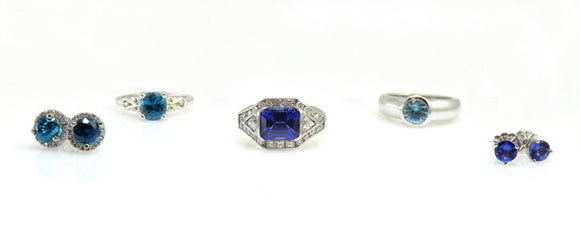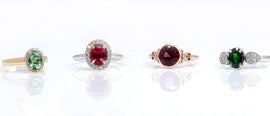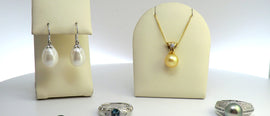Birthstones combine beauty with durability in spectacular – and often valuable – displays of color. They capture the imagination with their history and lore. Of the countless varieties of colored gemstones, the traditional birthstones below are most popular.
Durability is measured on the “Mohs Hardness scale” – which refers to a stone’s resistance to scratching. (1 is least resistant and 10 is the most – the only gemstone on the hardness scale that is a 10 is diamond.) However, a gem that has a high number on the hardness scale may still be delicate in nature. Toughness refers to a gemstone’s resistance to cracking and breaking. For instance, emerald is fairly high on the hardness scale at 7 1/2-8, but it is not a tough stone – and needs to be treated and maintained with care.
Gemstones have long been considered precious collectibles, and have been worn throughout history to signify social position and wealth. Many gemstones have also been associated with healing properties or other lore and legend. Modern birthstones did not exist until 1912, when the Jewelers of America developed a standardized list of birthstones for each month. Many months have more than one acceptable gemstone.
BIRTHSTONES
January – Garnet
Hardness: 7-7 1/2
Red garnet, called almandine garnet, is what we typically think of for a January birthstone. However, garnet comes in many colors. Pyrope is red with a brown or cinnamon tint to it. When it has a tint of violet it is called rhodolite garnet. Spessartite garnet is orange with red or brown in it. Grossular can be green, yellow or copper-brown. Tsavorite, which is a brilliant green, is a popular grossular garnet variety. Demantoid garnet is the most valuable garnet and is a nice emerald green. Garnet is found worldwide in the almandine and rhodolite varieties.
February – Amethyst
Hardness: 7
Amethyst is the most popular and valuable member of the quartz family. Look for a nice deep, transparent purple with flashes of red and blue. The darker shade is more desirable but it can be commonly found in a lilac color. Siberia and Brazil are the best color sources. Amethyst is common worldwide. Sunlight or ultraviolet light can cause amethyst to pale in color.
March – Aquamarine
Hardness: 7 1/2 – 8
Aquamarine is the blue variety of beryl. Medium to light aquamarine may be more common, but a darker ocean-blue color is more valuable and striking in appearance. Aquamarine can be found in intense teal tones, but over the years aquamarine is heated and the green is removed. The most popular color now is baby blue. Demand for a particular color can impact a stones’ history. Aquamarine was rarely heated but now the baby blue shade is so popular that the natural color is rarely seen. Common mining locations include India, Brazil and Nigeria. It can be found worldwide.
April – Diamond
Hardness: 10
Diamond is, of course, the most valuable and highly-sought after gemstone. It is also very rare. When someone says “diamond”, a white diamond is what immediately comes to mind, but diamonds also come in a rainbow of colors such as yellow, pink, green, blue, red and purple. Natural varieties of the “fancy” colors are extremely rare and therefore, very valuable. Diamond and natural zircon have the best brilliance and dispersion of light compared to other gemstones. This quality is the stones’ ability to bend light and return a variety of colors back to the viewer. Diamonds can vary drastically in value, even with two similarly appearing stones. When purchasing a diamond, always get a full explanation of the four C’s and how they impact the price.
May – Emerald
Hardness: 7 1/2 – 8
Bright, kelly green is the color of emerald. It is the green member of the beryl family and is the most precious of the group. Very transparent qualities are quite rare and valuable. Emerald commonly contains inclusions and this is widely accepted. Inclusions in emeralds are sometimes called “jardins”, a French word for garden because the inclusions themselves sometimes look like a garden. The best emerald comes from Colombia, with Brazil, Namibia and Zimbabwe being other high quality producers. Common synthetics are in the marketplace and are not always easily distinguishable from genuine emeralds.
June – Alexandrite
Hardness: 8 1/2
Alexandrite is a color change gemstone in the chrysoberyl family. Incandescent/fluorescent light will show different colors. Ideal quality shows green to red while more commonly the color changes from dark teal to purple. Natural alexandrite is very rare and highly prized. Russia and Burma are premier sources but Brazil, Sri Lanka and Madagascar have produced some wonderful examples.
June Alternative – Pearl
Hardness: 3 – 4
Pearl is commonly accepted as a birthstone for June as well. It is the only gemstone created by a living creature. White, pink and black Akoya cultured pearls are the most popular for their color, shape and high lustre. South Sea and Tahitian pearls are the most valuable and golden pearls are the rarest color. Chinese freshwater pearls are gaining in popularity as they are increasingly being created in the typical round shape. They can be found in a variety of colors such as white, pink, grey, black, and the ever increasingly popular “chocolate” (brown) pearls. Care should be taken when wearing pearls as they are prone to damage to the nacre from chemicals in perfumes and hair products.
July – Ruby
Hardness: 9
Ruby is the red variety in the corundum family. After diamond, it is the next hardest gemstone. It is commonly included and like emerald is accepted. It is often heated to remove silk like inclusions. This is an acceptable practice in the trade and has been done for hundreds of years. Burmese ruby is the highest quality but the supply is intermittent due to recent political issue. Star rubies are usually more opaque in color and have a six-point asterism which creates the star effect.
August – Peridot
Hardness: 6 1/2 – 7
Peridot is the gem quality stone from the mineral olivine. A nice deep apple green color is probably the most prized but peridot can also be very light in color or a deep olive green. It is not a very durable stone so care should be taken when worn on a daily basis. The finest peridot comes from Burma with Arizona, China and Venezuela showing differences in color in the olive tones.
September – Sapphire
Hardness: 9
Sapphire is a member of the corundum family of gemstones. The finest sapphire comes from Kashmir. The hue is a royal blue with almost an electric charge coming from within the stone. Blue is the most common color of sapphire but it can be found in a rainbow of colors such as white, yellow, pink, green and purple. Pink sapphires come in a variety of shades with bubble-gum pink being very desirable. Other mining locations include Burma, Thailand, Sri Lanka, Madagascar and Montana.
October – Tourmaline
Hardness: 7 – 7 1/2
Tourmaline is an increasingly popular gemstone that can be seen in a rainbow of colors such as light yellow, orange, pink, green, blue, brown and black. Watermelon tourmaline is a bi-color variety in pink and green. Paraiba is the rarest with pastel colors in a variety of hues. The most sought after is called “swimming pool blue” – an electric bright teal blue. This color is also found in parts of Africa. New Englanders may be interested to know that tourmaline is currently still being mined in Maine. Many in the gem and jewelry trade feel tourmaline is an underrated stone.
October Alternate – Opal
Hardness: 5 1/2 – 6 1/2
Opal is a gemstone, that unlike others, is not of crystalline material. Opal is partially comprised of water and could be best described as a solidified silica gel. The rainbow iridescence opal provides is what makes it desirable. Opal is seen with different base body colors. White which is semi-translucent, black which is usually opaque and dark or boulder opal which has a solid base formed from sediment. The finest opal is mined at Lightning Ridge in Australia. It is also found in Brazil, Sri Lanka, and Mexico.
November – Topaz
Hardness: 8
Historically, the November birthstone is golden topaz but because of it’s rarity, blue topaz or citrine is often used as a substitute. Precious topaz is gold with a slight pink hue. Imperial topaz is peach with pink and orange and is considered to be the finest color topaz. Topaz colors are typically light and are sometimes heated to intensify their color. Brazil is where golden topaz is mined and blue topaz is widely found.
December – Blue Zircon
Hardness: 6 1/2 – 7 1/2
Blue zircon is the most popular birthstone for December though turquoise has also been used. People sometimes believe that zircon is not a natural stone, confusing it with cubic zirconia. Blue zircon is teal blue and it becomes more valuable with the absence of green. Due to the intense blue combined with it’s light bending capabilities, blue zircon can look like blue diamond. Zircon can also be found in earth tones such as yellow and brown. It is mined in Nigeria, Cambodia, Sri Lanka and Brazil. Zircon also comes in many different colors and is often found in diamond mines.
December Alternate – Tanzanite
Hardness: 6 1/2 – 7
Recently, tanzanite was added to the gemstone array as another choice for December. It now now commonly being accepted as such. Tanzanite is mined in only one place in the world, Tanzania. Commonly, it is a light to medium periwinkle blue color but deep purple tanzanite is highly sought after and quite striking in its intensity. When the stone is faceted with a favorable orientation the color rivals that of Kashmir sapphire.





